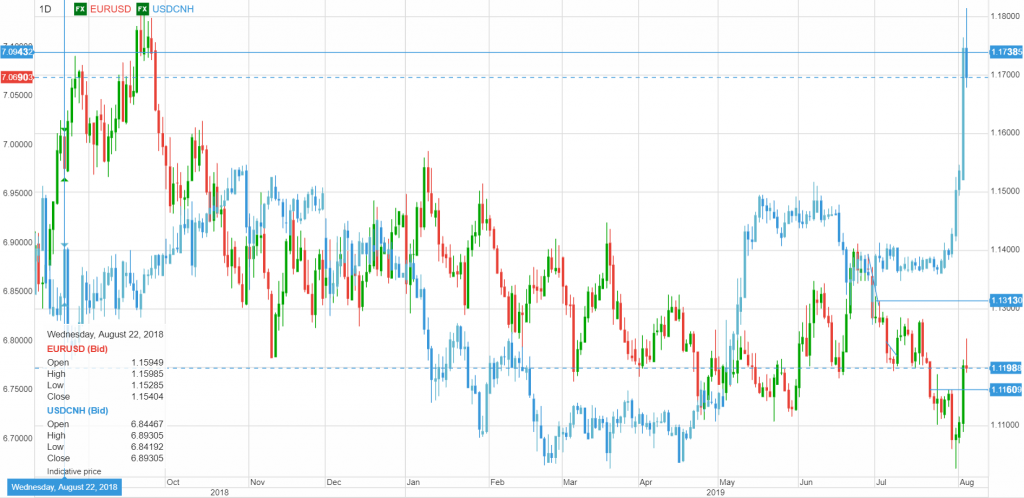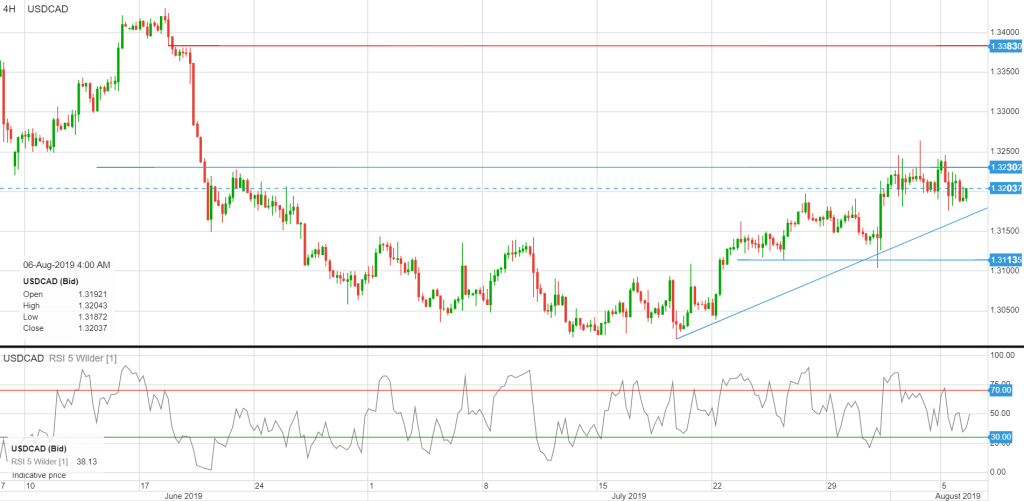
August 6, 2019
USDCAD Open (6:00 am EDT) 1.3200-03 Range (Fri. close-Tues. open) 1.3180-1.3244
Welcome back, Canada. While you were away, the stinky stuff, hit the whirling blades and financial markets were splattered. It started Monday when China allowed USDCNY to trade above the psychologically important 7.00 level. Traders believed it was a deliberate currency devaluation in response to President Trump’s latest tariff threat. Trump took exception to the move. Yesterday morning he tweeted “China dropped the price of their currency to an almost a historic low. It’s called “currency manipulation.” Are you listening Federal Reserve? This is a major violation which will greatly weaken China over time!”
I’m not sure if the Fed was listening, but Treasury Secretary Steven Mnuchin heard Trump’s complaint loud and clear. Shortly afterwards he officially designated China as a currency manipulator.
Wall Street stocks plunged, US Treasury yields tanked, oil prices sank, while safe-haven currencies, Japanese yen and Swiss Franc soared. Euro got into the act as well and rallied from 1.1195 to 1.1247.
China disagreed with the “currency manipulator” moniker. The Peoples Bank of China (PBoC) said China “has not used and will not use the exchange rate as a tool to deal with trade dispute.”
The USDJPY move was particularly nasty. Prices dropped from 106.20 to 105.58 as US 10-year Treasury yields fell from 1.782% to 1.676%. Risk sentiment improved slightly overnight after China fixed USDCNY at 6.9683, which sparked a tsunami of short USDJPY covering, lifting the currency pair from 105.54 to 107.08 in Asia. Prices retreated steadily in Europe and opened in New York at 106.36.
AUDUSD bounced after the Reserve Bank of Australia left interest rates unchanged. The decision was expected. However, RBA Governor Philip Lowe noted sluggish growth, which kept a rate cut on the table.
NZDUSD climbed from 0.6511 to 0.6588, underpinned by the broad improvement in risk sentiment and better than expected labour data. Despite the data, analysts still expect the Reserve Bank of New Zealand will cut rates by 0.25% on Wednesday.
EURUSD traders were busy. The single currency climbed from 1.1094 to 1.1246 overnight, in a fury of short-covering/profit-taking trades fueled by the rise in USDCNY with a dose of safe-have demand tossed in. Soft German economic data including weaker than expected Markit Services and Composite PMI and a dovish ECB policy outlook, helped drive prices down to 1.1200 in New York trading today
.Chart: EURUSD and USDCNY daily

GBPUSD rallied in concert with EURUSD rising from 1.2094 on Monday to 1.2208 in New York today. Traders ignored reports of Boris Johnson governments desire for a no-deal” Brexit. Prices tracked EURUSD moves with added support from better than expected UK Services PMI data.
USDCAD weathered the storm nicely. Prices stayed within a 1.3180-1.3244 band supported by recent domestic economic data suggesting the Canadian economy is expanding while soft oil prices undermine prices.
The economic data highlight for today is the JOLTS report, which isn’t a highlight at all. Instead, FX markets will follow the lead of Wall Street. US equity futures point to a positive opening this morning. Nevertheless, the escalation of the China/US trade war will keep traders on the defensive.
USDCAD Technical Outlook
USDCAD is consolidating gains in a 1.3190-1.3250 range, following the break of 1.3190 at the end of July. The uptrend line from July 18 is intact while prices are above 1.3170. A decisive break above 1.3250 targets 1.3450, For today, USDCAD support is at 1.3190 and 1.3160. Resistance is at 1.3250, 1.3290 and 1.3330. Today’s Range 1.3180-1.3250
Chart: USDCAD 4 hour

Source: Saxo Bank





